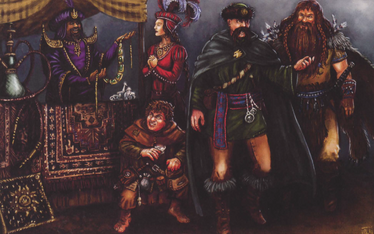"If you show up at the Countess' ball in those rags, you'll never live down the scandal."
- —Adelberd von Tinzberg, Nuln Noble

The Old World has a ride range of fashions, from the everchanging attires of the aristocracy to the stinking sackcloth robes of the flagellants. You can't wear armour forever; at some point you'll take it off. And when you do, what're you going to wear?[1a]
Style
Listed here, the following is arranged and organised in order of style. Style changes a great deal depending on where you are and with whom you associate. The Kislevites, for example, favour animal skins in their attire, meaning many have long wolf or bearskin cloaks. In Estalia, famed fencers are far less likely to bundle themselves up in Kislevite apparel, preferring instead loose and billowing shirts, tight trousers, and fashionable shoes. Their cloaks are in fact short capes, and nearly all men sport a dashing hat. Likewise, in Tilea, whose fashions tend to run closely to Estalia's (though no Estalian worth his salt would admit this), people wear longer cloaks because fencers incorporate them into their fighting styles, using the material to distract their foes and catch their blades.[1a]
The Empire, however, is different from the lands on its border. It is a large state comprising smaller principalities, as if several nations were united under one banner. Consequently, styles and fashion vary more throughout these lands than they do elsewhere. Generally speaking, clothes herald the social status of a person, so a well dressed adventurer is bound to be better received than a rag clad guttersnipe. The Empire is made up of three regional groups: Westerners, Northerners, and East Enders.[1a]
Westerners
The west consists of all the provinces west of the Reik and Aver, including Reikland, Averland, and Wissenland. These Westerners believe themselves to be the most advanced and modern of all their kinsmen. Having wealth, culture, and far more amenities than the crude Northerners and Easterners, Westerners benefit from well-equipped armies and a finger in most of the national politics. Many people, from wealthy citizens to peasants can afford clothing cut of decent cloth, as well as expensive dyes and patterns. Men typically shave, at most wearing large moustaches and sideburns. Women, on the other hand, are at the forefront of the Empire's fashion trends, setting the standard for the courts throughout the Old World. Their tastes are fickle, changing hems, necklines, colours, and accessories each year. Currently, though its changing even now, low-cut long dresses in bright colours along with colourful plumed hats are the current rage. As ever, the practice of slashing garments to reveal bright, sumptuous fabric beneath is still practices.[1a][1b]
Northerners
The Northerners come from the second region of the Empire, consisting of Nordland, Middenland, Ostland, and Hochland; they greatly distrust merchants, bureaucrats, and nobles. They see the Westerners as decadent and womanly. Instead of the pampered clothes of Westerners, Northerners tend towards animal skins. They disdain the face powder, silk, soft materials, and strange pretensions of the West. Northerners have ragged appearances, as they often wear their hair long and sport full beards that are sometimes braided like a Dwarf's. Women are encouraged to avoid the decadent clothing of the west, and most shy away from revealing clothes for conservative modest garb. This is not to say that the Northerners have little use for colour. it is quite the contrary, actually. Northerners embrace some of the most garish colour combinations of all the Empire in their cloaks, shirts, and plumes, seeing such unusual combinations as a point of pride. Amongst the nobles, the quality and type of fur worn is seen as an important social marker.[1b]
East Enders
The East Enders make up the final group, originating from the Ostland, Stirland, and Talabecland provinces. They are the exact opposite of the Westerners. Where the West is wealthy, advanced, and political, the east is noted for poverty, its sullen populace, and an isolationist attitude. Here, life is hard. Lacking the funds for elaborate styles of dress or even full suits of armour, Easterners wear drab apparel with a colourful sash, fur-trimmed hats in Kislev style, and heavy wool cloaks. Most men wear drooping moustaches and goatee beards. For women, hair length varies with the season, shorter in the summer months, longer in the winter months. Beyond the borders of the Empire, fashions, as described, run the gamut. The Estalian Kingdoms and Tilea mimic Western fashion trends. Araby merchants, on the other hand, wear long robes of dark cloth, elaborate turbans, and incorporate jewellery when they can. In Bretonnia, doublets are the rage, dyed in the colours of their particular house. Noble ladies wear long gowns in imitation of the images of the Lady of the Lake. Apparel is simple. Commoners wear heavy homespun tunics and breeches, over which they wear leather jacks. The upper class favours expensive clothing, though much of it replicates the attire worn by the lower classses, but of better materials.
Non-Humans
Halflings prefer the modest dress of the East Enders, wearing breeches, tunics, and vests, unconcerned by the Human fickleness towards personal style. Elves, however, wear bright and colourful clothing, sometimes pushing the limits of what even the Westerners deem acceptable. Incorporating expensive Cathay silks with other fibres, their apparel is as comfortable as it is beautiful. Through simplicity of pattern, Elves achieve a beauty that tailors throughout the Empire can only dream of creating. On the other hand, Dwarfs are predictably utilitarian in regards to ordinary clothing, and leather, wool, and iron are the typical materials.
